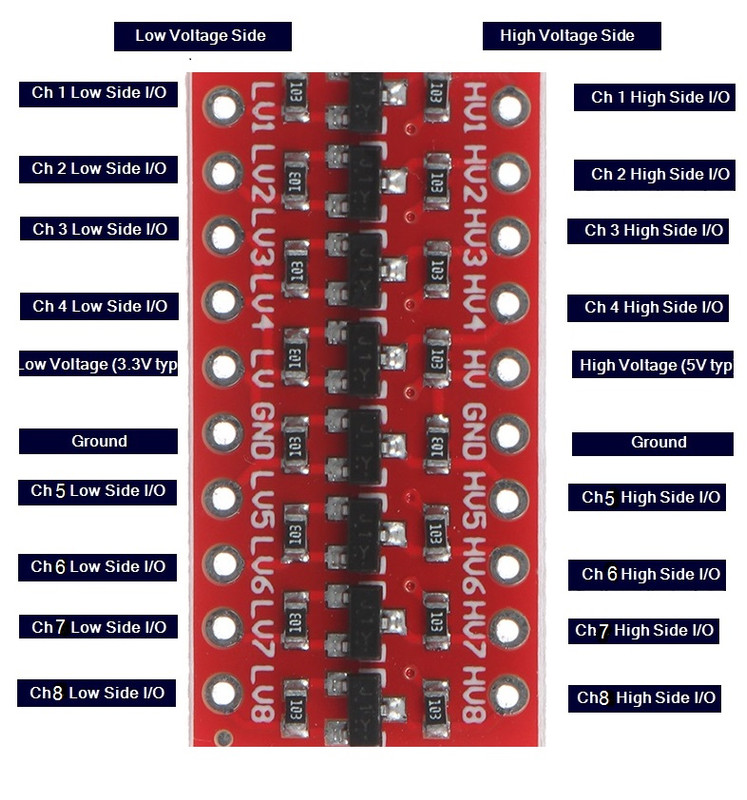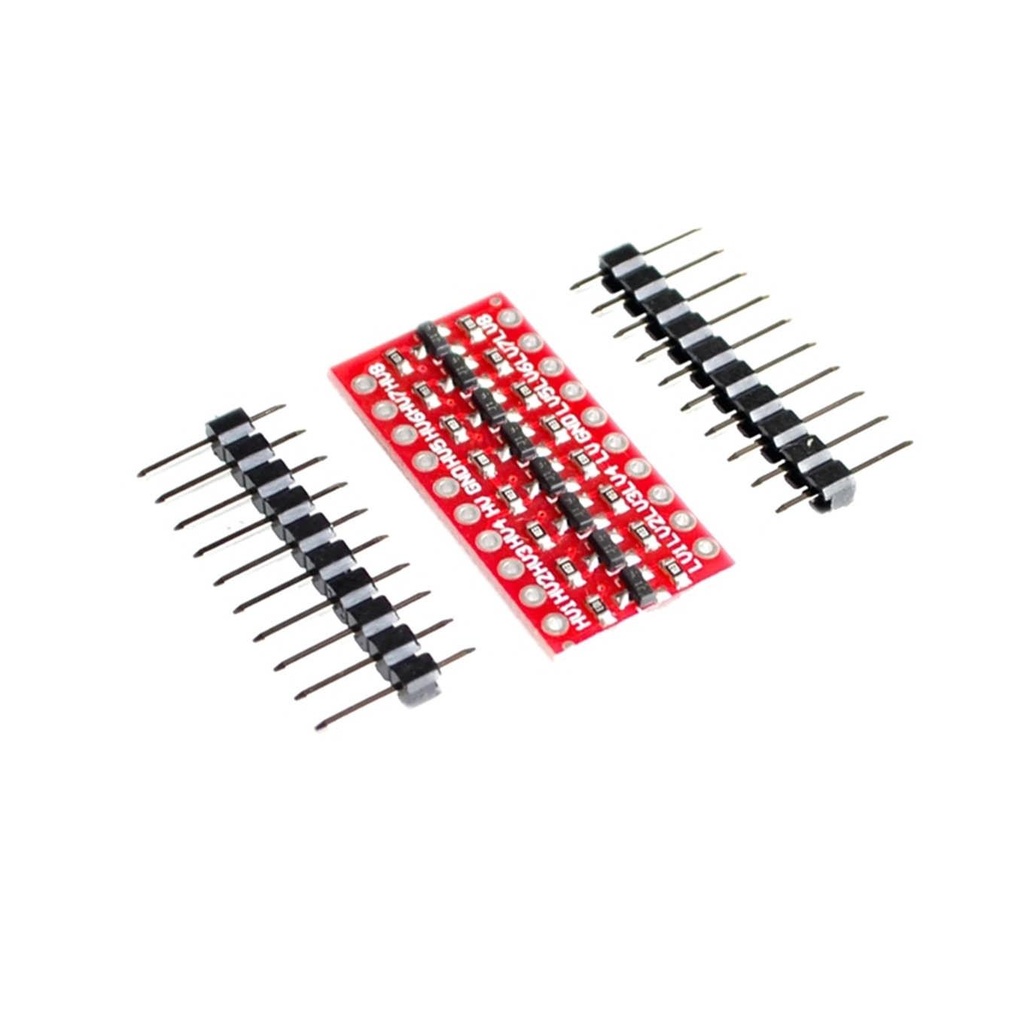Features:
- Bi-directional level shifting: Converts 5V to 3.3V and vice versa
- Compatible with 2.8V and 1.8V devices
- User-configurable high and low voltage levels
- Safe voltage level conversion on each channel
- 8 independent channels (each with HV and LV sides)
- Supports I2C, SPI, UART, and other communication protocols
- Compact red-colored module for easy identification
Principle of Work:
The module uses MOSFET-based circuitry to shift voltages between HV (high voltage) and LV (low voltage) sides. When a signal enters from one side, it is translated to the corresponding voltage level on the other side, allowing seamless communication between mismatched systems. Fast switching ensures minimal signal distortion or delay.
Pinout:

- HV1–HV8: High voltage side input/output pins (typically 5V logic)
- LV1–LV8: Low voltage side input/output pins (typically 3.3V logic)
- GND: Common ground
- VCC HV: Connect to high voltage (e.g. 5V)
- VCC LV: Connect to low voltage (e.g. 3.3V)
Applications:
- Microcontroller interfacing with 3.3V or 5V sensors/modules
- Level shifting in I2C, SPI, UART, ADC/DAC circuits
- Protecting low voltage devices from high voltage logic signals
- Debugging mixed-voltage digital systems
Circuit Example:
Example with DHT22 sensor (3.3V) and Arduino (5V):
- LV to 3.3V (Arduino 3.3V)
- HV to 5V (Arduino 5V)
- GND to GND
- HV1 to Arduino digital pin
- LV1 to DHT22 data pin

Code Example:
#include "DHT.h"
#define DHTPIN 2 // DHT data pin connected to digital pin 2
#define DHTTYPE DHT22 // DHT 22 (AM2302)
DHT dht(DHTPIN, DHTTYPE);
void setup() {
Serial.begin(9600);
dht.begin();
}
void loop() {
float h = dht.readHumidity();
float t = dht.readTemperature();
if (isnan(h) || isnan(t)) {
Serial.println("Failed to read from DHT sensor!");
return;
}
Serial.print("Humidity: ");
Serial.print(h);
Serial.print(" %\tTemperature: ");
Serial.print(t);
Serial.println(" *C");
delay(2000);
}
Usage:
Upload the code to your Arduino, open the Serial Monitor, and observe the temperature and humidity readings printed every 2 seconds.
How to Install DHT Library:
- Open Arduino IDE
- Go to
Sketch > Include Library > Manage Libraries
- Search for "DHT sensor library" by Adafruit
- Click "Install"
Technical Specifications:
- Operating Voltage: 5V and 3.3V
- High Side Voltage: 4.5V to 5.5V
- Low Side Voltage: 2.7V to 3.6V
- Output Voltage: 0V–3.3V (LV), 0V–5V (HV)
- Channels: 8
- Operating Temp: -40°C to 85°C
- Size: 28 × 19 mm
Comparison with Voltage Divider:
- Logic Level Converter: Bi-directional, safe, fast, low power, better signal integrity
- Voltage Divider: Simple, one-directional, more power loss, not ideal for digital signals
Conclusion:
The Logic Level Converter Bi-Directional Module offers a reliable and efficient solution for level-shifting in multi-voltage systems. With 8 channels, support for I2C/SPI/UART, and safe bi-directional operation, it's ideal for modern embedded systems and electronics prototyping.
Features:
- Bi-directional level shifting: Converts 5V to 3.3V and vice versa
- Compatible with 2.8V and 1.8V devices
- User-configurable high and low voltage levels
- Safe voltage level conversion on each channel
- 8 independent channels (each with HV and LV sides)
- Supports I2C, SPI, UART, and other communication protocols
- Compact red-colored module for easy identification
Principle of Work:
The module uses MOSFET-based circuitry to shift voltages between HV (high voltage) and LV (low voltage) sides. When a signal enters from one side, it is translated to the corresponding voltage level on the other side, allowing seamless communication between mismatched systems. Fast switching ensures minimal signal distortion or delay.
Pinout:

- HV1–HV8: High voltage side input/output pins (typically 5V logic)
- LV1–LV8: Low voltage side input/output pins (typically 3.3V logic)
- GND: Common ground
- VCC HV: Connect to high voltage (e.g. 5V)
- VCC LV: Connect to low voltage (e.g. 3.3V)
Applications:
- Microcontroller interfacing with 3.3V or 5V sensors/modules
- Level shifting in I2C, SPI, UART, ADC/DAC circuits
- Protecting low voltage devices from high voltage logic signals
- Debugging mixed-voltage digital systems
Circuit Example:
Example with DHT22 sensor (3.3V) and Arduino (5V):
- LV to 3.3V (Arduino 3.3V)
- HV to 5V (Arduino 5V)
- GND to GND
- HV1 to Arduino digital pin
- LV1 to DHT22 data pin

Code Example:
#include "DHT.h"
#define DHTPIN 2 // DHT data pin connected to digital pin 2
#define DHTTYPE DHT22 // DHT 22 (AM2302)
DHT dht(DHTPIN, DHTTYPE);
void setup() {
Serial.begin(9600);
dht.begin();
}
void loop() {
float h = dht.readHumidity();
float t = dht.readTemperature();
if (isnan(h) || isnan(t)) {
Serial.println("Failed to read from DHT sensor!");
return;
}
Serial.print("Humidity: ");
Serial.print(h);
Serial.print(" %\tTemperature: ");
Serial.print(t);
Serial.println(" *C");
delay(2000);
}
Usage:
Upload the code to your Arduino, open the Serial Monitor, and observe the temperature and humidity readings printed every 2 seconds.
How to Install DHT Library:
- Open Arduino IDE
- Go to
Sketch > Include Library > Manage Libraries
- Search for "DHT sensor library" by Adafruit
- Click "Install"
Technical Specifications:
- Operating Voltage: 5V and 3.3V
- High Side Voltage: 4.5V to 5.5V
- Low Side Voltage: 2.7V to 3.6V
- Output Voltage: 0V–3.3V (LV), 0V–5V (HV)
- Channels: 8
- Operating Temp: -40°C to 85°C
- Size: 28 × 19 mm
Comparison with Voltage Divider:
- Logic Level Converter: Bi-directional, safe, fast, low power, better signal integrity
- Voltage Divider: Simple, one-directional, more power loss, not ideal for digital signals
Conclusion:
The Logic Level Converter Bi-Directional Module offers a reliable and efficient solution for level-shifting in multi-voltage systems. With 8 channels, support for I2C/SPI/UART, and safe bi-directional operation, it's ideal for modern embedded systems and electronics prototyping.


